By Efthimios Georgiou (email)
Cinque Terre, a coastal region in northwestern Italy, is renowned for its striking landscapes, rich cultural heritage, and unique geomorphological features. The region’s five historic villages—Riomaggiore, Manarola, Corniglia, Vernazza, and Monterosso al Mare—boast a natural and built environment that is deeply intertwined, shaping its identity and economic trajectory. As a UNESCO World Heritage Site and a prominent tourist destination, the region faces the complex challenge of balancing economic growth with environmental sustainability and cultural preservation. The intrinsic characteristics of Cinque Terre’s geomorphology and landscape, with its dramatic coastal cliffs, terraced vineyards, and Mediterranean flora, offer a foundation for green economic development, fostering a model of sustainable tourism and conservation-driven regional policy.
Demographic and Socioeconomic Dynamics
Over the past five years, the region has experienced a steady population decline, averaging a 1.95% decrease across its three municipalities. This trend, common in rural and coastal areas of Italy, raises concerns regarding the long-term vitality of local communities. However, Cinque Terre undergoes a seasonal transformation, witnessing a population surge in summer due to tourism and the temporary return of residents with familial ties to the area (Table 1). This influx underscores the region’s dependence on tourism-driven economic cycles, necessitating sustainable strategies to mitigate the pressures of seasonal fluctuations on infrastructure, services, and natural resources.
Environmental and Cultural Heritage: A Pillar for Sustainability
The natural environment of Cinque Terre is not merely a scenic backdrop but a critical asset in fostering sustainable development. The Cinque Terre National Park, covering 3,860 hectares, is a key element in regional conservation efforts, protecting biodiversity and promoting eco-tourism. Its inclusion in the UNESCO World Heritage List further highlights its cultural and ecological significance. The interplay between terraced vineyards, Mediterranean flora, and dramatic coastal cliffs creates an unparalleled landscape that requires careful management to maintain its ecological integrity.
The region’s built heritage, characterised by vibrantly coloured houses perched along steep hillsides, cobblestone pathways, and historical sites, complements its environmental assets. Preserving these architectural features is not just a matter of conservation, but it also safeguards the region’s cultural identity and enhances its appeal as a sustainable tourism destination. Investments in heritage conservation, green infrastructure, and low-impact tourism activities are essential for ensuring that economic development does not come at the expense of environmental degradation.
Sustainable Tourism and Economic Development
Tourism is the primary economic driver of Cinque Terre, with visitor numbers fluctuating significantly in recent years. While the COVID-19 pandemic led to a temporary decline, the region has since experienced a strong resurgence, with nearly 4 million tourists recorded in 2023. This growth presents both opportunities and challenges. On the one hand, tourism generates employment and revenue, reinforcing local businesses and cultural initiatives. Conversely, the sheer volume of visitors, particularly in peak months, strains local resources and threatens the fragile equilibrium between tourism and daily life.
To navigate these challenges, regional policymakers have prioritised sustainability in tourism development. Measures such as regulated visitor flows, eco-friendly transportation systems, and investments in community-based tourism initiatives have been implemented to enhance long-term resilience. The extensive network of walking trails linking the villages provides an alternative to mass tourism, promoting slower, more immersive experiences that minimise environmental impact.
Policy and Infrastructure: Enhancing Regional Connectivity
Effective policy interventions are crucial in fostering green economic development in Cinque Terre. A comprehensive approach must integrate cultural preservation, environmental protection, and infrastructure enhancements. The region’s train network, which seamlessly connects the villages along the coast, exemplifies a sustainable transport model that reduces reliance on private vehicles, lowering carbon emissions. Affordable ticketing and scenic routes enhance accessibility while maintaining a light ecological footprint.
Additionally, the conservation of Cinque Terre’s terraced landscapes is a priority. These centuries-old terraces, supported by dry-stone walls, are cultural artefacts and serve an ecological function by preventing soil erosion and supporting biodiversity. Sustainable agricultural practices, including the revival of traditional viticulture, contribute to environmental preservation and economic diversification, reducing the region’s overdependence on tourism.
Conclusion
Cinque Terre’s unique geomorphology and landscape provide opportunities and constraints for its future development. By leveraging its environmental assets and cultural heritage, the region can serve as a model for sustainable economic growth that harmonises tourism, conservation, and local livelihoods. Ensuring a balanced approach that respects the territory’s ecological limitations while fostering innovation in green infrastructure and policy will be essential in securing a resilient and thriving future for Cinque Terre and similar regions facing comparable sustainability challenges.
References
Georgiou ES. Cartographical digital products: Maps, 3D models, diagrams. Journal of Geography and Cartography. 2024; 7(1): 4514. https://doi.org/10.24294/jgc.v7i1.451
Raso, E., Mandarino, A., Pepe, G., Calcaterra, D., Cevasco, A., Confuorto, P., … Firpo, M. (2020). Geomorphology of Cinque Terre National Park (Italy). Journal of Maps, 17(3), 171–184. https://doi.org/10.1080/17445647.2020.1837270




